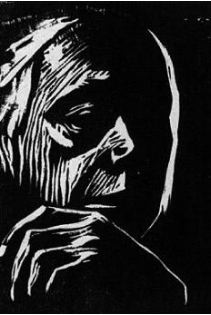
Born to a middle-class family of Christian dissidents in Königsberg, East Prussia, Käthe Ida Schmidt was fortunate to have a liberal-minded father who encouraged her talent. Although women were barred from studying at the Academy, Schmidt began private art lessons with a copper engraver in 1881. Her education continued at the Schools for Women Artists in Berlin and Munich, from 1885 to 1889.
Two years after completing her training in Munich, Schmidt married Dr. Karl Kollwitz and moved to Berlin, where her husband built a practice chiefly serving the poor. In her art, Käthe Kollwitz, too, occupied herself with the plight of those less fortunate. In 1894, she received a prize from the German Art Exposition in Dresden for her cycle Revolt of the Weavers, which consisted of three lithographs and three etchings loosely based on Gerhard Hauptmann’s play The Weavers. By the beginning of World War I, she was recognized as one of the most prominent German graphic artists and had already involved herself in various social, political and artistic organizations, among them the Berlin Secession and the satirical weekly Simplicissimus.
At the age of eighteen and only two months after enlisting in the German army, Kollwitz’s youngest son, Peter, was killed in battle in October 1914. Peter’s death and a growing recognition that the horrors of war were unjustifiable transformed Kollwitz into a committed pacifist. Her 1918 response to the poet Richard Dehmel’s call for all able-bodied men and boys to die for the Fatherland, published in the Social-Democratic newspaper Vorwärts, quoted Goethe: “Seed corn must not be ground.” The nation’s future, she implied, depended on its youth, which must not be squandered in a war of attrition.
The artist’s haunting images from the interwar period chronicle the hunger and misery then seen in Germany and elsewhere. The 1919 woodcut Memorial to Karl Liebknecht honors the murdered Spartacist leader (whom Kollwitz admired, despite differing political views), the 1921 poster Help Russia, created for the Internationale Arbeiterhilfe, highlights Russian strife, and the War cycle of 1921-22 examines war’s civilian cost. Overtly anti-war works, such as the iconic poster Never Again War!, spur their viewers to action.
In 1919, Kollwitz was appointed the first female professor and member of the Prussian Academy of Fine Arts. In 1928, she became the director of the master studio for graphic arts at the Academy of Fine Arts in Berlin. All the while, she worked on a memorial to her son, a sculpture of two mourning parents, which in 1932 was installed in the Vladso German war cemetery in Belgium.
Although she was not often harassed by the National Socialist Party, Kollwitz was forced to resign from the Academy of Fine Arts, in part due to her support of an “Urgent Appeal” to unite socialist and communist leaders against fascism. Another run-in with the Nazis took place in 1936, when the Gestapo threatened her with deportation to a concentration camp for an interview she had granted the Soviet newspaper Izvestia–though there were no further consequences.
Following the tragic loss of her grandson (also named Peter) in battle in 1942, Kollwitz returned to Goethe’s words, realizing the lithograph Seed Corn Must Not be Ground. Kollwitz herself died in 1945, shortly before the armistice was signed.